
10 very hardy, frost-resistant trees
A selection suited to cold climates and resistant to frost.
Contents
Trees are the pillars of the garden. They add verticality and height. They also provide beneficial shade: sometimes dense to shelter from blazing sun, sometimes light to allow planting bushes and perennials beneath their branches. Some are prized for their attractive foliage, flowering or fruit, and their silhouette can be admired in every season, even in the heart of winter. Of rapid or slower growth, there is something for every taste and situation, from large park to small town garden, and you can use them in hedges, in beds or as solitary specimens. Those I present here offer an extra advantage, namely that they do not fear cold and are therefore frost-hardy. Here is a selection of 10 trees with hardiness to spare for all regions of France, even those with very harsh winters!
White hawthorn, a legendary fragrant flowering
White hawthorn (Crataegus monogyna) is a medium-sized tree, ultimately reaching between 5 and 10 m. Its deciduous foliage, bright glossy green, is deeply divided into 5 to 7 lobes. Leaves are borne on short, thorny branches with purplish tints. The trunk, fissured, shows grey to brown tones. In May, this hawthorn is covered in small, fragrant white flowers. These are followed by round red berries, also of small size, which extend its ornamental interest and are a favourite of birds. This species adopts an upright and rounded habit, and fits very well into mixed and country hedges. Very long-lived, hardy to at least -20°C, plant in any well-drained soil, even slightly calcareous, in full sun or partial shade.

Beautiful spring flowering of white hawthorn (Crataegus monogyna) followed by its red berries in autumn
→ Discover our hawthorn varieties and our guide to planting, pruning and caring for them.
Read also
6 remarkable MaplesHimalayan White Birch, King of Winter
Himalayan white birch (Betula utilis jacquemontii) is a magnificent variety that catches the eye in every season. In spring and summer, its ovate, finely dentate, dark green leaves lend the tree great grace. They cast a pleasantly light shade. Spring flowering in greenish-yellow aments is very unobtrusive. In autumn, its deciduous foliage gradually turns to a brilliant golden-yellow, brought out by the setting sun. Come winter, this birch reveals the incomparable beauty of its bark. Smooth in texture and marked with lenticels, it is pure white! With an upright then spreading habit, a mature tree reaches 15–20 m in height with a 5–8 m spread, but allow about 5 years on average before it shows its best. Its numerous, shallow roots stabilise soil but can quickly suffer from drought. It is however very hardy and withstands -20°C without flinching. Plant in fresh but well-drained soil, acidic or slightly calcareous, in full sun or partial shade. Used as a specimen or in groups, it is a must in winter gardens!
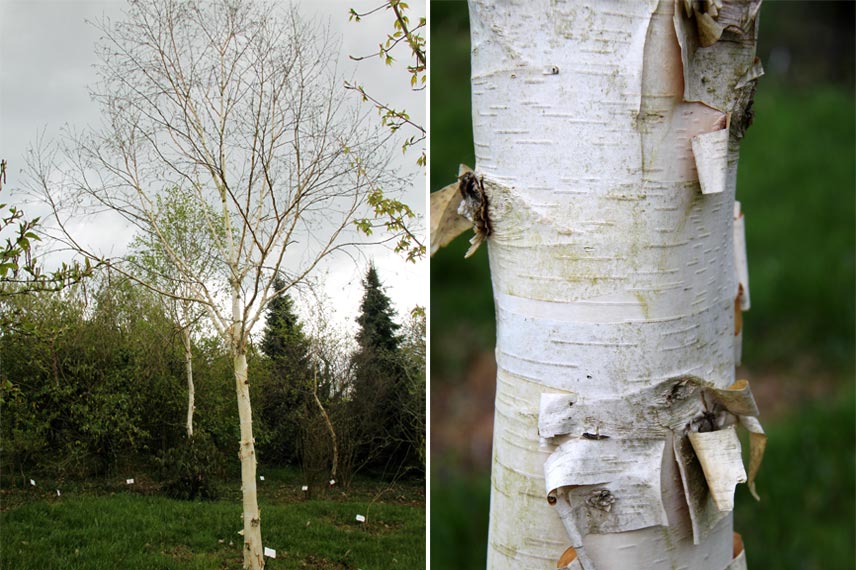
Bark of Himalayan white birch (Betula utilis Jacquemontii)
→ We offer a wide selection of birch varieties on our online nursery, as well as a guide to planting, pruning and maintenance.
Discover other Trees and large shrubs
View all →Available in 0 sizes
Available in 1 sizes
Available in 1 sizes
Available in 1 sizes
Available in 1 sizes
Available in 1 sizes
Available in 1 sizes
Available in 1 sizes
Available in 2 sizes
Available in 1 sizes
Purple honey locust: foliage with changing colours
Purple honey locust (Gleditsia triacanthos f. inermis ‘Ruby Lace’) is a majestic, fast-growing tree that can reach 15 m. Its slender silhouette showcases a dark, straight, fissured trunk on which are inserted thornless branches with a horizontal habit. The main asset of this variety is its deciduous foliage, glossy, finely divided and ever-changing in colour. It appears late in spring, reddish-purple, then develops green and chocolate tones, finally turning to deep yellow in autumn. Its sparse branches produce light shade that does not harm nearby plants. Its flowering is melliferous but inconspicuous, and its fruits, flattened pods similar to those of wisteria, contain edible pulp. Its root system is mainly deep and taprooted. You can therefore plant it near a terrace. Its wood is, however, rather fragile and susceptible to wind.
It thrives in rich, moist soil, even poorly drained and calcareous, although it can grow in poorer, drier soil. Plant in full sun and protect young plants from severe frost. Once established, it can withstand temperatures down to -20°C, or lower.
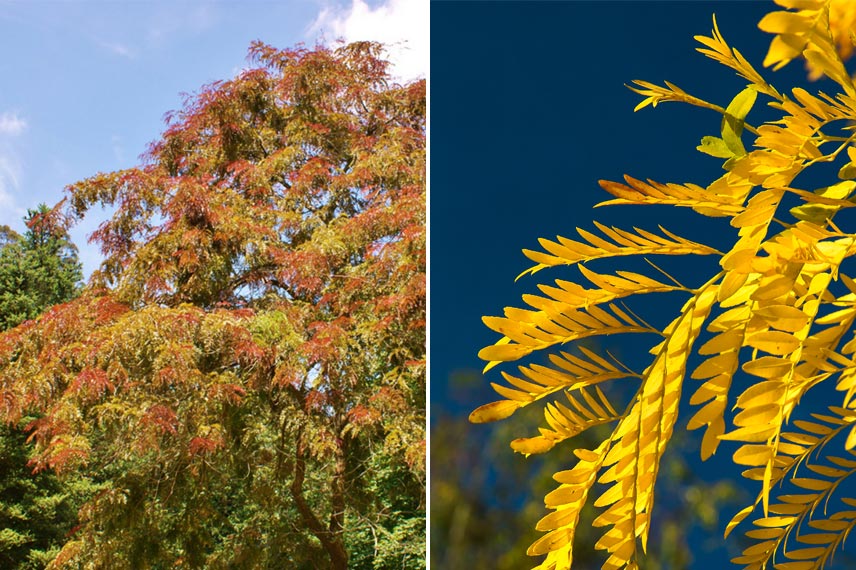
Comparison between chocolate-toned foliage of Gleditsia Ruby Lace (left) and golden-toned foliage of Gleditsia Sunburst
→ Also discover Honey locust ‘Sunburst’, with very luminous golden foliage
Amur Maackia, an elegant tree to discover
Elegant small tree, Amur River Maackia (Maackia amurensis) is little known and seldom planted. Yet it is easy to grow and perfectly hardy (-20°C, possibly colder). Its deciduous foliage breaks bud in astonishing silvery tones, with metallic reflections. Covered with frost-like bristle, the young shoots are particularly decorative. Its large leaves, divided into numerous leaflets, are olive green with greyish highlights. The branches, dotted with lenticels, bear from June to August white to pale yellow flowers, in upright spikes, slightly scented and much appreciated by pollinators. Its brown, glossy bark also develops an attractive appearance with age. Maackia’s habit, spreading and open, provides pleasant shade, which can be enjoyed on a terrace. With rather slow growth, it eventually reaches 10 m, with at least as much spread. Able to draw water from deep down, give it light, humus-bearing and cool but not waterlogged soil, in a sunny, even very warm, position. It tolerates some lime but does not like strong winds, which can break its branches.
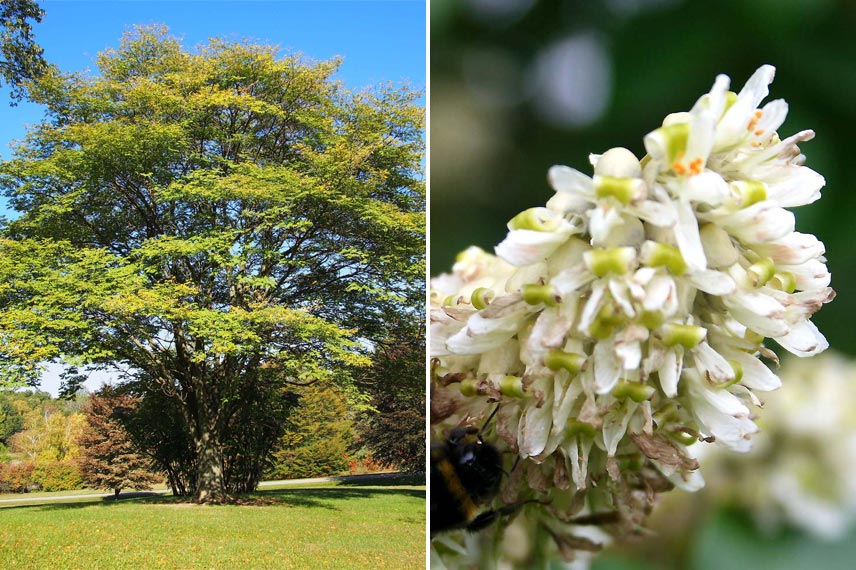
Maackia amurensis and its slightly scented white flowers
Common hornbeam 'Rockampton Red', not so common after all
Hornbeam ‘Rockhampton Red’ (Carpinus betulus ‘Rockhampton Red’) hides its charms. Although as easy to grow and as hardy as the typical species, it stands out for a truly beautiful autumn display! Its marcescent foliage (that is, leaves that, even when withered, remain attached to branches for much of winter), crinkled and dentate, is green in summer. By contrast, from autumn it blazes in orange and vivid red tones to put the finest Liquidambars and maples to shame. Generous, it retains its late-season colours for a long time. Flowering appears as small pendulous aments in spring or summer, depending on the sex of the tree. With slow growth, it eventually forms a fine specimen 20 m high by 15 m wide, with a pyramidal habit. Tolerating pruning well, it is suitable both as a specimen and in a hedge. Very hardy (down to −20°C) and undemanding, it adapts to any deep, fresh but well-drained soil, even calcareous (it is intolerant of acidic soils), in partial shade or in non-scorching sun. However, it can withstand short periods of drought and prefers to be sheltered from drying winds.
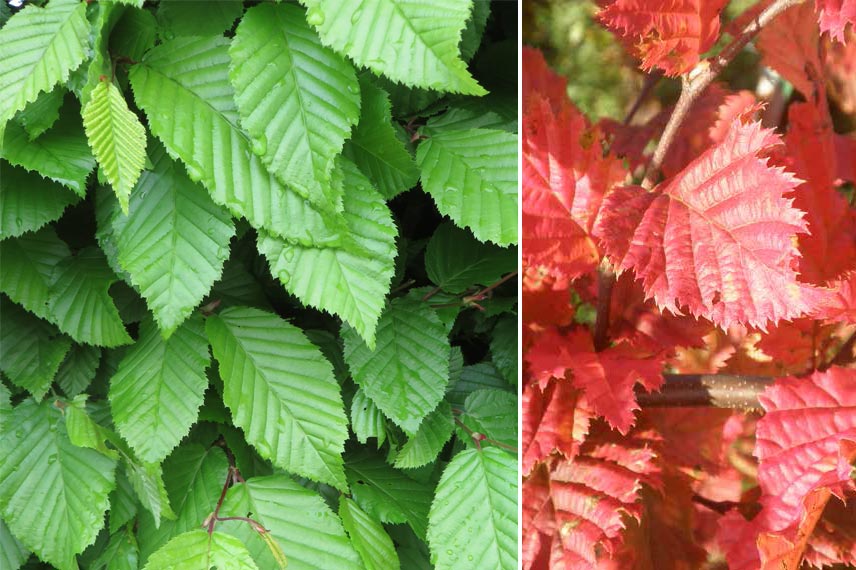
Nice contrast between the green foliage of the hornbeam (Carpinus betulus) and the red-leaved hornbeam Carpinus betulus Rockhampton Red
→ All our hornbeam varieties are available online.
→ In our dossier, we tell you everything about planting, pruning and maintenance of hornbeams and hornbeam hedges.
Weeping Willow: Romanticism and Majesty
Silhouette of the Weeping Willow (Salix alba ‘Tristis’) is instantly recognisable, and its popularity is well deserved. This large tree (20 m x 20 m) with a rounded habit bears very long, pale-yellow, flexible trailing branches that can reach the ground and sometimes form a leafy grotto. Its deciduous foliage, light green, turns yellow in autumn. In spring, pale-yellow aments stud the branches, enhancing its natural charm. With rapid growth and able to withstand winters across all our regions, cultivation is also very easy. It simply needs deep, cool (even moist) soil, even heavy clay, not too alkaline, in a sunny exposure. A symbol of romanticism, it is superb beside a body of water, where its languid silhouette is reflected.

Long, flexible branches of the Weeping Willow (Salix alba ‘Tristis’) trail in a cascade to the ground
→ Discover our wide range of willows.
→ Learn how to plant, prune and maintain willows in our complete guide.
Forty-Écu Tree 'Blagon' — Longevity and Stature
Undoubtedly one of the oldest living trees on earth, the Tree of Forty Coins has long inspired admiration. The Ginkgo biloba ‘Blagon’ differs from the species by much more modest dimensions. With slow growth, especially during early years, it reaches 10 m and has a limited spread (about 2 m), which allows it to be integrated everywhere, including urban gardens (it also tolerates pollution) where space is at a premium. Its deciduous, characteristic foliage consists of fan-shaped leaves, green during growing season, then dazzling golden yellow in autumn. Even when bare of branches, its narrow, conical habit and graphic silhouette make it a standout specimen. With a spreading root system, it excels as a solitary specimen or planted in multiples to form an exceptionally elegant row. Hardy to -30°C, it fears only two things: waterlogged soils and prolonged high heat, which cause it to suffer. Ensure it has a sunny aspect and fertile, deep soil that remains cool in summer. Under these conditions, it can even cope with slightly calcareous soils. Finally, do you know secret of its longevity? To learn more, visit the blog: “No planned obsolescence for Ginkgo biloba“!
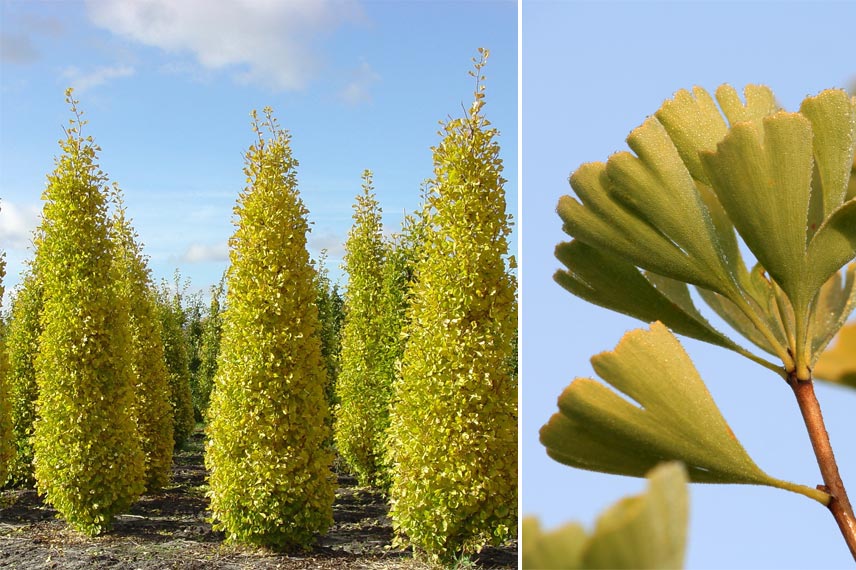
Ginkgo biloba Blagon’s yellow-green foliage turns golden yellow in autumn
→ Discover our selection of Ginkgos and how to plant, care for and use them in the garden.
Red maple 'Red Sunset', like an autumn sunset
The Red Sunset red maple (Acer rubrum ‘Red Sunset’) is a tree of fine vigour and rapid growth, reaching 15 m high and 10 m wide. It therefore needs some space to develop fully. Its well-structured, pyramidal silhouette highlights deciduous palmate leaves with pronounced lobes that emerge green, tinged with red. This red is also found in the petioles of its leaves, its abundant winged fruits (on older specimens) and its small fragrant, melliferous flowers which appear on bare wood in early spring. Even its young shoots show carmine hues. But it is in autumn that this colour is most spectacular, when the whole tree erupts in crimson and orange tones. It is truly like a sunset in your garden! Easy to grow, red maple flourishes in deep, cool soil, even clayey, heavy and moist, with a tendency to acidity. Its beneficial shade makes it suitable as a solitary specimen, but it also fits well on the edge of a large plot, integrated into a mixed hedge. Hardy to -20°C, it can even be grown in town, provided salt in all its forms is avoided (road salting, sea spray…). Plant in full sun or partial shade, and simply admire!
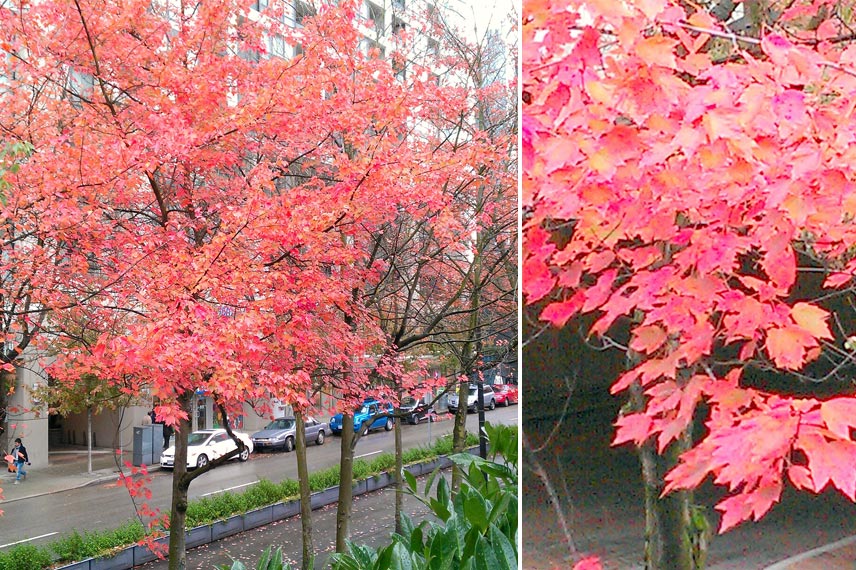
Vibrant colours of red maple leaves (Acer rubrum Red Sunset)
→ A very wide selection of maples is available from our nursery.
→ Read: Planting, pruning and care of maples.
Variegated holly, bright and multifunctional
Variegated holly (Ilex aquifolium ‘Argenteomarginata’) is a small tree that reaches no more than 8 m in height and 3 m in width. Its evergreen foliage, thick and thorny, is a glossy green variegated with cream. With age it adopts a dense, pyramidal habit. Of relatively slow growth, it takes pruning very well and lends itself to many uses. Planted singly, it showcases the brilliance of its foliage, but can equally be used as a defensive hedge, as neat topiary, in a pot on a terrace or trained as a standard. It thus adorns large spaces as well as modest-sized gardens, without demanding much care. On female plants, its discreet flowering gives way to small bright red, glossy berries in autumn, and these persist long into winter, bringing even more colour under grey skies. Hardy to −20°C, it easily withstands −20°C, and grows in neutral or acidic soil. It tolerates pollution and sea spray, but can be intolerant of strong winds. In summer, cool soil is preferable.
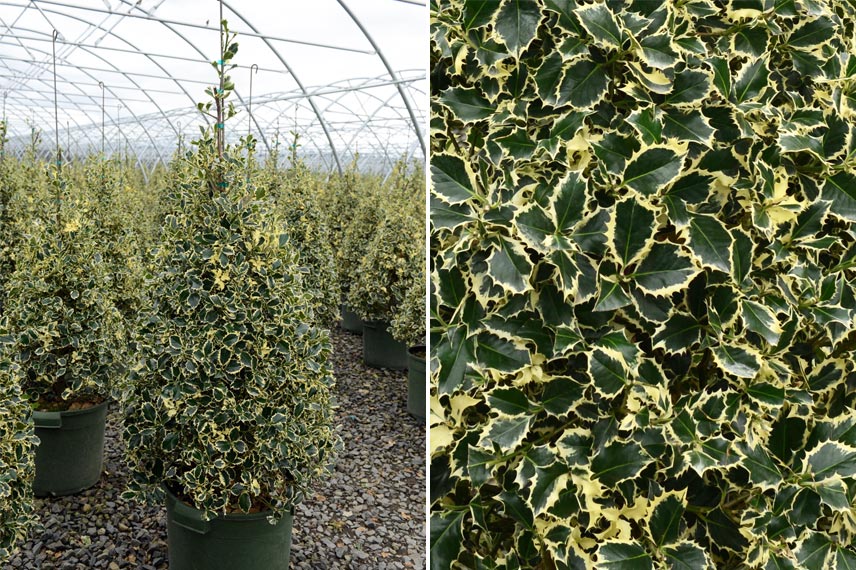
Pyramidal habit of variegated holly (Ilex aquifolium ‘Argenteomarginata’)
→ Wide selection of holly awaits in our nursery.
→ To grow them successfully, consult our guide: Planting, pruning and caring for holly.
European larch, a gentle yet sturdy giant
European larch (Larix decidua) is a deciduous conifer of imposing proportions (30 m x 20 m). It is therefore suited to large spaces or to parks and sizeable gardens. Its tender foliage, light green at bud burst period, displays a clear green in summer before turning a golden yellow in autumn. It produces, between March and July, male and female cones, the latter showing a vivid pink colour. The trunk develops into a straight bole, from which horizontal shoots emerge that tend to droop. The bark, in more or less grey or purplish tones, tends to form scales with age. With moderately fast growth, it is extremely hardy down to -40°C. Use it as a specimen, in a group of trees if space allows or even as a bonsai to enjoy it in the smallest spaces.
Its only requirements are well-drained but deep cool soil, even if poor and calcareous, and a sunny aspect. Avoid heavy, waterlogged soils, as well as excessively dry and arid situations. Its large tap root helps it withstand winds and allows it to draw moisture from depth.
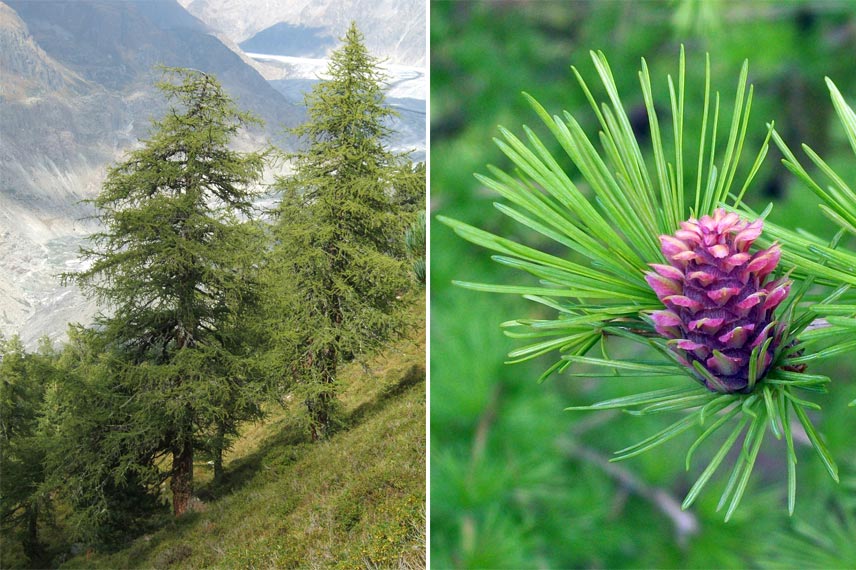
Each year the thorns of the European larch are renewed in spring
→ Discover our other varieties of larch, as well as our extensive range of conifers.
→ Also read our feature on Larch: planting, pruning and care.
Note: plant resistance to cold is influenced by many factors. To find out which, consult Elizabeth’s article, which tells you everything you need to know about hardiness!
- Subscribe!
- Contents
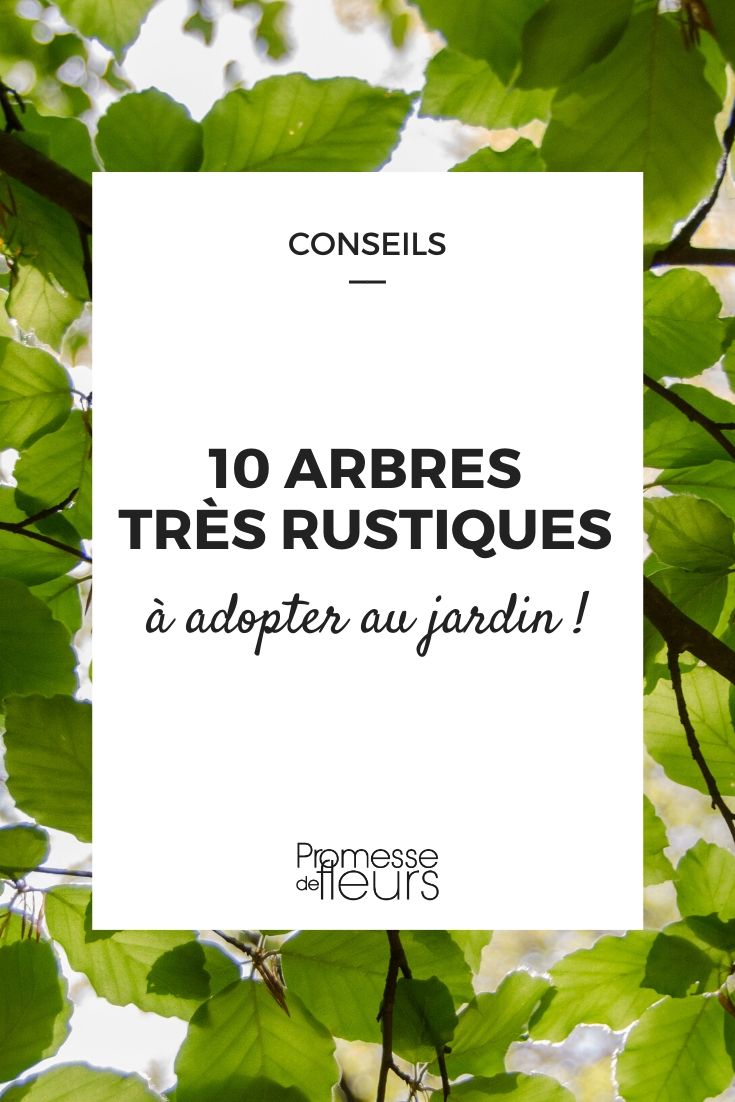


































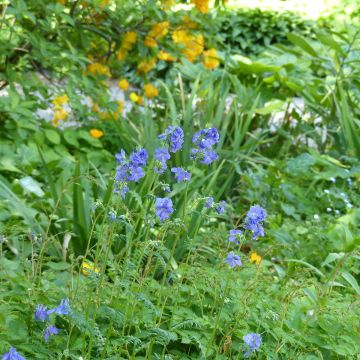
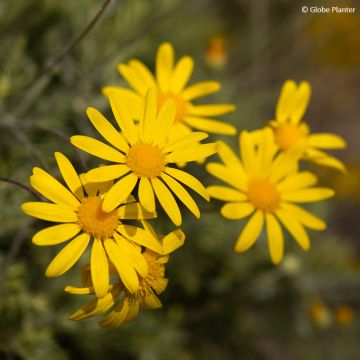
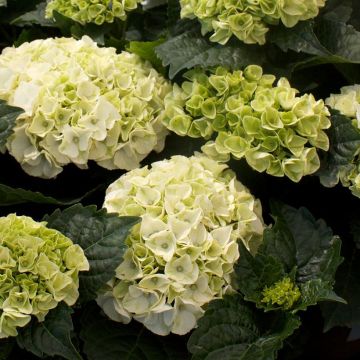
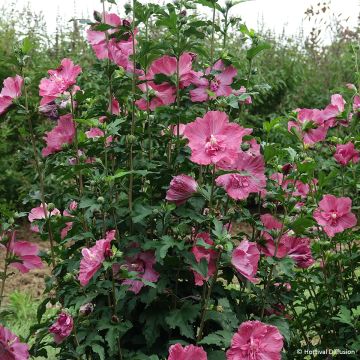



Comments